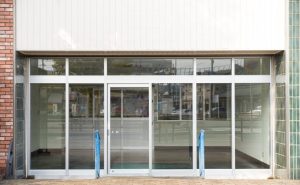Coworking – a growing trend in the office market
 The concept of coworking (from the English. Co-working – collaboration) is simple, but very functional: the interested party (employee) on a rental basis offers a comfortable and fully equipped workplace.
The concept of coworking (from the English. Co-working – collaboration) is simple, but very functional: the interested party (employee) on a rental basis offers a comfortable and fully equipped workplace.
As a separate segment of the office market, coworking began to develop most actively during the last 10 years. The growing popularity of this format is associated with the consequences of the global financial crisis, which demanded optimization from employers, the global “boom” of startups and the formation of a new sharing economy.
Coworking. The employee receives a comfortable, fully equipped workplace on a rental basis.
The employee receives a comfortable, fully equipped workplace on the terms of the lease GaudiLab /
Knight Frank estimates that over the past decade, the number of coworking, or “flexible offices,” has increased by 3,500% in the world, and the number of people working in them — by 8,000%. According to the same data, there are at least 18,000 such sites in the world, which are ready to accommodate from 1.7 million people.
How does coworking work?
At the heart of co-working is the principle of open space (open space), fully equipped with office equipment and necessary furniture. Jobs in coworkings are rented to individual employees for different periods of time – from one hour to several years.
The function of organizing such sites is usually assumed by operators concluding contracts with building owners. At the same time, owners and operators can choose for themselves various options for cooperation:
Rental model. The operator and the owner sign a lease agreement (usually for a period of 10 to 20 years). In this case, the operator undertakes to make regular rental payments, and also undertakes the cost of repairing and equipping the premises.
Joint Venture Model. The operator and the owner enter into an agreement whereby the property owner, as an investor, contributes the majority of the initial capital. For this, he acquires the right to first-come profits from coworking activities (its size is negotiated by agreement). The co-working operator becomes the managing partner and exercises operational control over the co-working activity.
The management model. In this case, all operational costs are borne by the building owner. The operator, in turn, is responsible for the design of the site, the search for customers and the promotion of coworking.
Coworking. Space owners and coworking operators can choose for themselves various options for cooperation.
Owners of premises and coworking operators can choose for themselves various options for cooperation.
Model franchise. The owner of the property is responsible for all capital investments and manages the workspace independently. As a franchisee, he pays a certain commission and annual license fees to the coworking operator. The operator ensures that the new coworking meets the standards of its brand.
Owner-operator. Such a model begins to function if the co-working operator decides to purchase the property where his site is located, or the building owner decides to independently develop “flexible offices”.
Coworking formats can be very diverse.
The simplest is a mixed type of “flexible office”. In this case, representatives of various fields of activity and companies can coexist in the same room. Coworking can be specialized. Then, employees of the same industry (for example, the IT industry) or young start-ups gather under the same roof. By developing business in similar areas, companies quickly exchange ideas and information, forming a common business environment.
In addition, co-working can be organized on the principle of lifestyle-project. The rate will be made on the balance of work and personal life (the operator will pay more attention to the ergonomics of the room, providing in it, for example, recreation areas). Members of such coworkings can receive various benefits, including discounts at gyms, restaurants, etc.
There are also more non-standard formats, for example, coworking for athletes, gamers, parents with small children, and even fans of silence.
According to the Global Coworking Survey survey, the classic “flexible office” usually covers an area of about 800 m, where 70 workplaces are equipped. The average age of employees is slightly older than 36 years, almost 41% of co-working space members are freelancers, 36% are self-employed. The most numerous group of “coders” are representatives of the IT industry, the second place belongs to specialists in the field of PR and marketing.
Professional status of coworking worker
Despite the fact that most residents of co-working are still freelancers, in recent years large employers have begun to come to such sites. IT giants such as Microsoft, IBM, Amazon and Google have already transferred some of their employees to the “flexible offices”.


